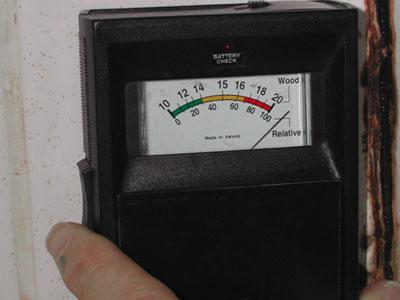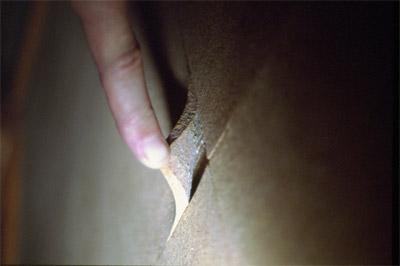Mold Course Chapter 3:
Finding Mold and Moisture
Lesson 1 - Where to look for mold contamination - building investigation
As discussed in Chapter 2, mold can grow in wet or damp spots in a building, or where humidity is high. Therefore, it is important to look for indoor areas where moisture is a concern. Chapter 2 lists a number of factors that may contribute to indoor humidity and moisture problems. Reports of any of these problems should be investigated. If there has been a leaking pipe in the basement, for example, items such as carpets, paneling and drywall there should be checked for water damage or mold growth. It is important to dry items quickly to prevent mold growth; in most cases, items dried within 24-48 hours will not become moldy. See Chapter 2.
Carpet
Carpet backing or padding must be dried in addition to the carpet or mold will likely result.
Look for mold in wet or damp places and in places that smell moldy or musty. Indoor mold growth should be cleaned up. Remember that mold comes in many colors, not just black.
Hidden Mold Growth
In some cases, indoor mold growth may not be obvious. Mold does not need light to grow, it can grow in dark areas and on hidden surfaces such as:
- The backside of drywall
- Wallpaper
- Paneling
- The top side of ceiling tiles
- The underside of carpets and pads
Possible locations of hidden mold also include:
- Damp areas behind walls and in crawlspaces
- Inside pipe chases and utility tunnels (areas in walls where water and other pipes are run)
- On acoustic liners in ventilation ducts
- On roof materials above ceiling tiles
Investigating hidden mold can be difficult and may require a professional with experience investigating water- and mold-damaged buildings. Specialized equipment such as borescopes and moisture meters, and in some cases special sampling techniques, may be helpful in locating and identifying hidden mold areas. Investigating hidden mold requires caution since disturbing moldy areas may spread mold throughout the building. Opening and closing air handlers, for example, can send high levels of dust and mold into the air. Personal protective equipment, or PPE is not always needed when looking for mold, but it should always be available. If mold might be released into the air, investigators should use PPE to reduce exposure.
Homes
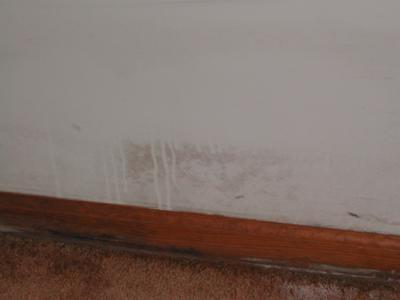
Areas that are always or often damp, such as bathrooms, laundry/utility rooms and basements, are common locations for mold growth in homes. Regularly check areas that have been or are likely to get wet. If you hire a home inspector, building inspector, or other professional to locate a water or mold problem, make sure the professional has experience identifying and locating mold and water problems. Check references and look for membership in professional organizations.
Commercial Buildings, Large Buildings and Schools
A key step when looking for mold in a building is to determine whether there has been a water leak. Maintenance personnel are frequently among the first to know when moisture problems have occurred. In some cases, management or health and safety personnel will have been notified. Either way, touring the building with maintenance or other personnel involved with the water problem may be helpful.
If possible, crawl spaces should be included when examining the building. (A white, soluble fibrous material on the soil of the crawl space may be alkaline salts, not mold, indicating moisture has been a problem and suggesting that the area should be more extensively inspected.)
Moldy or musty odors should alert an investigator to the possible presence of mold. Complaints of past water problems or water leaks should be investigated to determine how much water was involved and how quickly it was removed.
The building's air-handling system should be inspected to determine whether it is moldy. Moisture may collect in the ventilation system due to poor condensate pan drainage, poor roof drainage, or high humidity in the ventilation ducts. In some cases, water may enter the ventilation ducts from a leaky pipe. A contaminated ventilation system may spread mold spores throughout the building and should be considered a high priority for investigation and repair. Ventilation system mold contamination should be mitigated as soon as possible in a manner that does not expose building occupants to dust and mold spores. (See Chapter 6.)
During the building survey, any moldy or damp odors should be noted because damp or musty odors suggest that water is or was present and mold growth is likely. Occupant complaints of odors and health problems also should be investigated.
Lesson 2 - Equipment
In general, the most important equipment is your own eyes and nose, although a good flashlight may help. Some investigators use a borescope to look for mold growth behind walls without significantly damaging the drywall. (A borescope is an optical probe, inserted through a small hole drilled into a wall, that lets an investigator inspect a small portion of the wall without causing extensive damage.) High humidity in a building can lead to mold growth, so humidity gauges may be useful for checking or monitoring humidity throughout the building.
Many investigators use moisture meters to find wet areas where mold may be growing. These meters measure the moisture in many types of building materials. They also can monitor the process of drying these materials. A moisture meter typically has a thin probe that can be inserted into the material to be tested or pressed directly against its surface. Moisture meters can be used on:
- Carpet
- Wallboard
- Wood
- Brick
- Concrete
Because mold often grows where moisture is high, a moisture meter can help an investigator locate hidden areas of mold growth.
The use of personal protective equipment (PPE) should be considered during a mold investigation. The primary function of PPE is to avoid inhaling mold and mold spores and to avoid mold contact with the skin and eyes. Professional judgment should be used when selecting PPE. The use of PPE is indicated when mold is disturbed and likely to become airborne during an investigation. There are also other situations when PPE should be used based on professional judgment. Anyone using respirators and other PPE in the workplace must be trained, must have a medical clearance and must be fit-tested by a trained professional. Note that all Occupational Safety and Health Administration, or OSHA requirements must be met. For more information see:
Lesson 3 - Mold Sampling Considered
Visible Mold
In most cases, if visible mold is present, sampling is unnecessary. The most important sign of a mold problem is visible mold. If mold is found during a building investigation, the size and extent of the moldy area should be determined. Information on the water or moisture problems that allowed the mold to grow should be evaluated, in part because areas of hidden mold may surround the areas of visible mold.
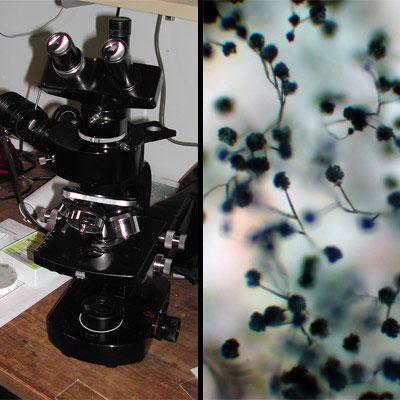
Is sampling for mold needed? Usually, if the mold can be seen, sampling is unnecessary. After finding mold, the goal is to clean it up and fix the underlying water problem. Unless the results would or could make a change in your plans, you don't need to sample. Under certain circumstances, such as when litigation is involved, the source of the mold is unclear, or health concerns are a problem, you may consider sampling as part of your site evaluation. However, routine sampling for mold is not recommended. Keep in mind that the goal of mold remediation is to find the source of the water problem, fix it and clean up the mold.
Sampling may help locate the source of mold contamination, identify some of the mold species present and differentiate between mold and soot or dirt. Surface sampling may be useful in determining if an area has been adequately cleaned or remediated. After remediation, the types and concentrations of mold in indoor air samples should be similar to those in the local outdoor air.
Sampling for mold should be conducted by professionals who have specific experience in designing mold sampling protocols, sampling methods and interpreting the results. Several problems can occur when sampling, for example:
- There may be too few samples
- Sampling protocols may not be followed consistently
- Samples may become contaminated
- Outdoor control samples may be omitted
- Since sampling can be expensive, sufficient funds may not be available to sample and to fix the water/mold problem
Professional advice may be necessary to determine if the project budget will allow enough samples to be taken to characterize a problem. If sampling cannot be done properly and enough samples to answer the questions posed cannot be taken, then it is preferable not to sample at all. Inadequate sample plans may generate misleading, confusing and useless results.
Samples should be analyzed according to the analytical methods recommended by the American Industrial Hygiene Association, or AIHA, the American Conference of Governmental Industrial Hygienists, or ACGIH, or other professional guidelines. See the Resource List.
Types of samples include:
- Air samples
- Surface samples
- Bulk samples (chunks of carpet, insulation, wall board, etc.)
- Water samples from condensate drain pans or cooling towers
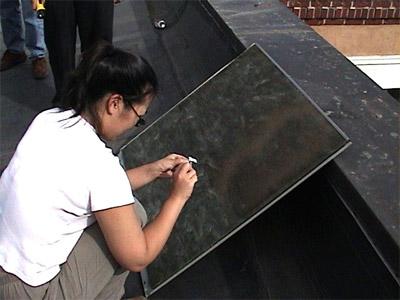
Keep in mind that air sampling for mold provides information only for the moment when the sampling took place. For someone without experience, sampling results will be difficult to interpret. Experience in interpreting results is essential.
Mold Versus Soot and Dirt
Not everything that looks like mold is mold. Paint on the backside of drywall or wood may look like mold growth. Alkaline crystals on soil or concrete walls may look like mold, but, unlike mold, they are usually water-soluble. Carpet stains also may look like mold.
Some inexpensive and quick tests can be conducted if mold is suspected. In the case of carpets, a small portion of the suspect material can be submitted to a laboratory for identification. Most microbiology laboratories need only a little of the suspected mold on a clear strip of sticky tape to determine, using a microscope, whether it is actually mold or something that looks like mold. If you lack extensive experience or are in doubt about sampling, consult an experienced professional. Remember, sampling results may have limited use or application.



